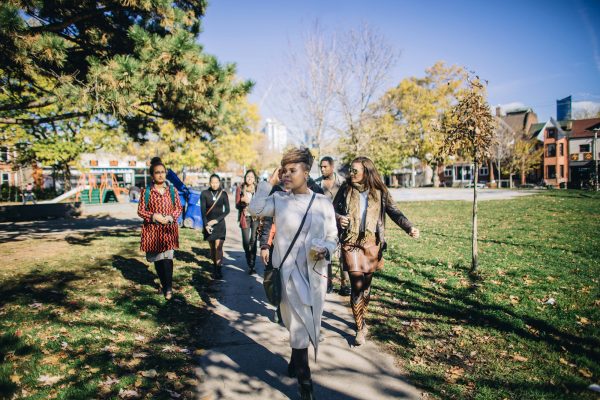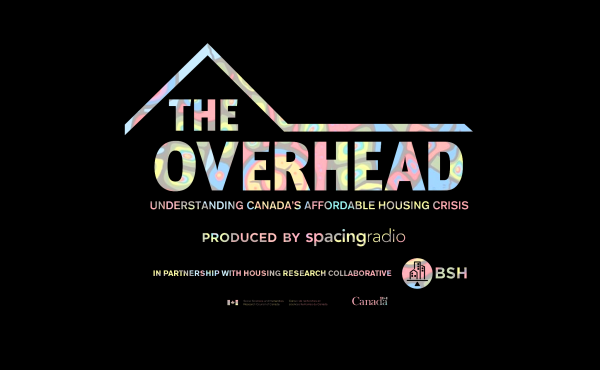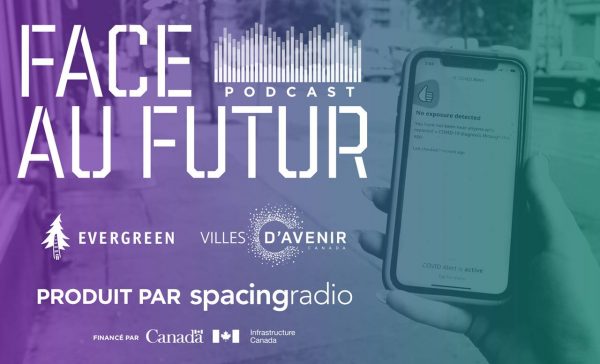Ahead of Park Peopleãs first national city parks conference in Calgary this coming March 2017, Park Peopleãs Jake Tobin Garrett caught up with keynote speaker Jay Pitter,ô an author, placemaker, senior stakeholder engagement professional, and frequent Spacing contributor. Her work focuses on increasing the capacity, resources, and relationships required for co-creating more inclusive, safe, and vibrant cities.
Jake Tobin Garrett: The vision of the organization you work for, the Inspirit Foundation, is to create a more inclusive and pluralist Canada where differences are valued and engaged. How do you see that vision relating to parks and public spaces?
Jay Pitter: In addition to acknowledging and addressing systemic inequities,ô we believe that encouraging an inclusive and pluralist Canada is predicated on encouraging people to engage each other across difference. The public realm plays a large role in that. The Inspirit Foundation supports many projects that leverage the public realm to bring people together to address issues that are paramount within their local context.
For instance, we funded an Edmonton-based project called iHuman. The project provides supports for Indigenous youth, many of whom are street-involved, to engage with the broader community in the public realm. Last year they hosted a block party and there were performances and workshops led by Indigenous youth who are street-involved engaging the wider community. Whatãs really exciting about this project is it really recast Indigenous youth who are experiencing homelessness from being a vulnerable to powerful. The project demonstrates their capacity not just their struggles; the public realm plays an integral role in amplifying this respectful approach to youth engagement and addressing systemic exclusion.
JTG: In a very visible way, too.
JP: Yes, and in a visceral way too. While itãs important to address issues at the systemic level, thereãs something powerful about how change, hope, and tension can be felt on the street-level. Weãve attempted to employ policy and formalized training to address issues of social equity and inclusion for many years. However, we also need to support initiatives in the public realm that bring people together to sort things out themselves. Aô project that encourages this on-the-ground public engagement is MABELLEarts. The foundation funded the organization to host workshops in Etobicoke. Thereãs a public park and its betwixt high-rise buildings where there are a lot of low-income and newcomer families. On the other side is established, higher-income suburban communities where the residents are generally of European descent and higher-income earners. The workshops will culminate in four open Iftars [the breaking of the Ramadan fast] which will happen in the park. Itãs an educational experience, but in a very experiential way. Thereãs a way that the park can, in a very natural manner, facilitate people coming together, participating in this meal and learning about the Muslim faith. Again, I think thereãs something very visceral and intimate about learning about faith and culture in this manner rather than having heady, and often polarized conversations in formal spaces.
JTG: I donãt want to bring the recent US election into this really, but thereãs been a pretty divisive and hateful conversation in the US. And in Toronto as well weãve seen some of that bubble up. Iãm wondering if you think parks and the public realm will have an increasing importance as a place to have these conversations and work some of these things out.
JP: Absolutely, I think so. Prior to the Trump election the Provincial government here in Ontario was hosting conversations about racism in formal public spaces. Theyãd pack four hundred people in a room with a microphone and a deep sense of disenfranchisement. Unsurprisingly, the results were disastrous. People spent much of the time hurling rage and insults across the room. I believe that parks are a much better venue for having difficult conversations. Iãm not suggesting that parks are neutral spaces. In fact, parks can be sites of increasing violence, inappropriate policing, and tension. However, they are beautiful, more intimate spaces, which can create the conditions for creative, intimate, and productive exchanges.
JTG: We often hear a lot about the word placemaking and I think weãre not often sure what it means. What is your placemaking practice?
JP: Placemaking is a multi-disciplinary approach to the planning, design, and management of public places. While many practitioners and thought-leaders often stress important ideas such as walkability, economic sustainability, community consultation, triangulation, and belonging, they fall short when it comes to issues of equity. Iãm explicit about equity and inclusion in my practice and research. As far as Iãm concerned consulting a community is meaningless if we donãt take into account the systemic barriers faced by community members and intentionally design public spaces, which facilitate movement, mental wellness, opportunities, and a sense of hope. To achieve this, you must be willing to have nuanced and uncomfortable conversations pertaining to class, race, gender, sexual identity and Indigenous land rights. Traditional placemaking and engagement processes are often rushed and incomplete.
JTG: The idea of traditional engagement is often come out to this meeting or fill out this online survey or put a dot on a map or something. What does engagement mean to you?
JP: From my perspective, true engagement is predicated on communities both shaping and co-leading the conversation. Itãs also important that they have a clear understanding of options and scope of influence on final decisions. Sadly, most engagement processes simply provide space for community members to respond to narrowly framed prompts, fail to take the time to really educate communities about their options, and pretend to be ãneutralã.
In my practice, Iãm always asking myself. ãWhoãs not here?ã Although I work from an extremely inclusive framework, I never allow myself to become complacent or arrogant. Inclusive placemaking is complex and on-going work. In addition to keeping myself accountable, this question ensures that the same handful of privileged and often loud voices (able to interpret dense planning documents and take the afternoon off work) arenãt dominating the discussion. The other thing Iãm mindful of in my work is rejecting the notion that my job is to solve a problem. This is a key tenant in urban planning practice and a debate I often have with traditional planners. The thing is that long before planning was formalized, people self-organized and solved their own issues. As such, I think that the focus should be less on problem solving and more focused on listening, asset-mapping, and contributing to community resilience. Even when Iãve been brought in to solve a problem because itãs been determined that this group of people or this placeãthat something is not working, somethingãs gone askewãI still begin by listening for whatãs working. Iãm always looking for the asset in the individual or the community or the place.
JTG: Why do you start off by asking whatãs good, even in certain cases where someoneãs said ãOh this is the issue we have to deal with here?ã
JP: Imagine having an outsider parachute into your community and beginning a placemaking conversation or process by listing off its ãproblemsã. For many professionals, they are simply stating a fact or referring to the conditions of a place. For people connected to particular communities and places, itãs deeply personal not factual or incidental. Focusing on issues sets the tone for mistrust, shame, and deeply imbalanced power dynamics. Iãm not denying that communities and public places face many serious issues; Iãm suggesting that itãs really important to build on peopleãs knowledge and what theyãre doing really well. It also situates the expertise in the community. I never want to be the person who gets parachuted into a community to tell whatãs not working. When I look at what is working, I know that my starting point is informed by the local context and not my knowledge or even biases. I think thatãs where we brush up against this notion of centering expertise rather than community. I absolutely bring my expertise into the process, but I begin by listening to and honouring whatãs exceptional about every community and stakeholder group I have the privilege to work with. I think much of this sensitivity is derived from being a kid who grew up in social housing and witnessing the ways my communityãs knowledge and capacity was disregarded.
JTG: This kind of goes into the next question, which is Iãve heard you say that itãs not about empowering people, but understanding people are already powerful. We often see that language: empower the community. Can you explain a little bit about the distinction?
JP: People are innately powerful. Sure, there are systems and personal choices, which can impede the manifestation of this power, but everyone has something valuable to offer. When placemaking professionals claim to empower individuals or entire communities, it negates this inherent power. It is also incredibly arrogant. It takes considerable focus and hard work to foster personal and professional power; the notion that one has so much power to grant others is magical thinking. That said, I understand what placemakers and others mean when they claim to empower others. Itãs often well-intended and meant to convey a desire to share resources and encourage participation. However, itãs important to recognize multiple forms of power. For example, many of us work for organizations with institutional power such as budgets, research, and the ability to shape policy. This is not the only form of power. Individuals and communities are also powerful. They have in-depth knowledge of inner-workings of their communities, stories, strong informal networks, and a passion for making positive change. Itãs also important to remember that many communities, even those considered marginalized, tend to be extraordinarily resilient and able to problem solve in a highly intelligent manner. For these, and many other reasons revealed through my practice, I think itãs disrespectful to claim to ãempowerã others.
JTG: This kind of goes back to what you were saying about that first step being listening to people and asking them about whatãs good, what they like, and whatãs working well in their community.
JP: Absolutely. When we say weãre empowering a neighbourhood or a group of people, weãre also negating the fact that cities have historically been comprised of self-organizing groups who possess incredible insights around creating local networks. For example, think about neighbourhoods like The Ward, once considered ãslumsã, these neighbourhoods were quite sophisticated. They had local industry, places for worship, ways to integrate newcomers into the community, childcare, ways of supporting older people to age in place. I would argue that some of those communities were better off before planning and municipal interventions.
JTG: I want to go back a little bit to talk about parks and public spaces where different groups of people meet and sometimes clash. Iãm thinking of that story you told at an event I was at recently about people organizing large family picnics in a park and making goat stew and how that didnãt necessarily jive with what some other people would say is a ãtraditional park picnic.ã When these sorts of tensions arise, what are strategies we can use to have a constructive dialogue about different ways of using public space?
JP: I think we must have the courage to unpack these kinds of coded criticisms. They are almost always directed to visible newcomers. The real issue isnãt the goat stew. The issue is that park culture and etiquette has been defined by European values and cultural practices for many, many years. Thereãs an unspoken etiquette regarding ãappropriateã behaviours such as playing Frisbee and barbequing hamburgers. Some newcomer communities are preparing entire feats in the parks, taking long naps on comforters, and have large inter-generational families. While I think most people are welcoming to everyone in parks, there are sometimes unspoken tensions and power dynamics pertaining to the ways the space is occupied.
JTG: We work with a lot of community members that are volunteering their time in parks to do improvement projects and animate and program parks. Do you have any advice to community groups to help them think about new ways to engage and reach out to other people in their neighbourhood?
JP: More than ever parks are places where activities once considered private are happening in the public realm. I really respect the work of volunteers animating parks and appreciate that parks are increasingly becoming places of ritual, courageous conversation, art-making, and meals fostering community connections. In terms of local engagement, itãs important for people animating parks to allow for a certain degree of organic and fluid interaction. This is a part of what makes parks wonderful and so we must be careful not to inadvertently institutionalize parks through over-programming. Also, parks respond to their local context so there arenãt prescriptive ways of animating them but at a high level Iãd recommend the following:
- Always begin with asking, ãWhoãs not here?ã While parks can be welcoming to everyone, they are not socially neutral spaces. Parks have long and complicated histories of targeting gay men, excluding poor people, and profiling Black youth. These are unpleasant histories but we must be aware of them to understand why some groups may not be as eager to participate in park activities or feel safe. When we identify groups missing from parks, we can begin to explore barriers and develop more inclusive engagement plans.
- There are too many community gardens in the world. Iãm not suggesting that community-gardens are bad. I quite like them and recognize their positive environmental, social, and public health impacts. Iãm just suggesting that park programming is not always responsive to specific local needs. Some neighbourhoods would benefit more from a playgroup for isolated single mothers and their children or a walking group for newcomers with high rates of diabetes. Itãs important to listen and be responsive to the ever-changing needs of the local community.
- When animating public spaces, we often focus on ãinvitingã others and ensuring that they feel a sense of belonging. This is important but letãs go a step further. When programming park spaces engage neighbours and local organizations at the front-end to ensure that everyone feels a sense of true ownership not simply belonging.
Again, I really respect the work of volunteers but itãs also important to remember that all three levels of government have a responsibility to invest in our public parks. We donãt have a shortage of parks or generous, creative, and intelligent people to animate them. We have a shortage of funds to support the hard work being done in parks, which cuts across several funding silos such as housing, economic development and newcomer settlement. Iãd like to see this recognized in terms of increased funding and recognition of the contributions of volunteers. We need to invest more in people and parks to optimize their possibility.
This conversation has been condensed and edited for clarity



